I'm trying to get the text "P1" and "P2" from the upper left corner of the video.
I take a frame and crop them down to following images and then apply the image processing found here:
use pytesseract to recognize text from image
and while it works on cropped still images I edited manually using an image editor, it doesn't work when taking frames from the video using cv2.
I'm not sure why this is but I suspect it has something to do with the black and white background like in the picture below, but I don't know how to get rid of it without also removing the text.
and here's my code
import cv2
import pytesseract
import re
from difflib import SequenceMatcher
def determineWinner(video):
winnerRect = [(70,95),(146,152)]
cap = cv2.VideoCapture(video)
if(cap.isOpened() == False):
print("No dice")
return
fps = cap.get(cv2.CAP_PROP_FPS)
frames = cap.get(cv2.CAP_PROP_FRAME_COUNT)
print(fps)
print(frames)
desiredSeek = frames - int(fps * 9)
print(desiredSeek)
seconds = desiredSeek/fps
print(seconds)
minutes = seconds/60
print(minutes)
partial = minutes - int(minutes)
print(partial)
seconds = partial * 60
print(seconds)
print(str(int(minutes)) +":"+ str(seconds))
cap.set(cv2.CAP_PROP_POS_FRAMES,(desiredSeek))
ret,img = cap.read()
winTxt = []
p1Count = 0
p2Count = 0
cv2.namedWindow("",cv2.WINDOW_NORMAL)
ret,img = cap.read()
while ret:
key = cv2.waitKey(1)
if key == ord('q'):
break
if key == ord('e'):
ret,img = cap.read()
if ret:
winROI = img[winnerRect[0][1]:winnerRect[1][1],winnerRect[0][0]:winnerRect[1][0]]
gray = cv2.cvtColor(winROI, cv2.COLOR_BGR2GRAY)
blur = cv2.GaussianBlur(gray, (3,3), 0)
thresh = cv2.threshold(blur, 0, 255, cv2.THRESH_BINARY_INV + cv2.THRESH_OTSU)[1]
# Morph open to remove noise and invert image
kernel = cv2.getStructuringElement(cv2.MORPH_RECT, (3,3))
opening = cv2.morphologyEx(thresh, cv2.MORPH_OPEN, kernel, iterations=1)
invert = 255-opening
invert=cv2.resize(invert,None,fx=2,fy=2)
wConfig='-l eng --oem 1 --psm 10 -c tessedit_char_whitelist=P12'
winTxt = pytesseract.image_to_string(invert,config=wConfig)
cv2.rectangle(img,winnerRect[0],winnerRect[1],(255,0,0),2)
cv2.imshow("winroi",invert)
cv2.imshow("",img)
cv2.resizeWindow("",800,600)
print(winTxt)
desiredSeek+=1
seconds = desiredSeek/fps
minutes = seconds/60
partial = minutes - int(minutes)
seconds = partial * 60
print(str(int(minutes)) +":"+ str(seconds))
else:
break
cap.release()
cv2.destroyAllWindows()

